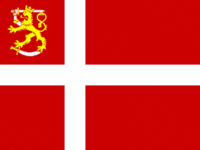Finland

| |
| Motto: None | |
| Subdivision of: | Scandinavian Realm |
| Cities: | |
| Capital: | Turku (Åbo) |
| Largest: | Turku (Åbo) |
| Other: | Helsinki (Helsingfors) |
| Languages: | |
| Official: | Scandinavian, Finnish |
| Others: | Saami |
| State Minister: | Tarja Halonen |
| Area: | AREA |
| Population: | POPULATION ADJECTIVE |
| Established: | YEAR, DECREE OR REASON |
Finland is an independent member state of the Scandinavian Realm located around the Bothnian Gulf, composed of the former Swedish provinces of Finland Proper and Qvenland.
Administration
Government
DESCRIPTION ON HOW THE SUB-NATIONAL ENTITIY IS GOVERNED
Administrative Divisions
Finland is divided into two provinces:
History
Swedish and Nassian influence on the Finns was already considerable in pre-Christian times. The Swedish vikings were known to Finns both due to their participation in commerce and plundering. In Finland Proper, the Nassians helped organize the Finns into fortified communities, which were then united under Nassian leadership. On the place of Finnish fortified community, the Nassians built the city of Rookokortu (later Turku or Åbo). Rookokortu extended its rule throughout Finland Proper, which became the Nassian principality of Mothina (Marshland).
In 1003 the Nassian principalities, including Mothina, united in Sëttikortu to form the kingdom of Nassland. In 1045, civil war broke out in Nassland when its fourth king, Lippikosëtu, died. He had planned to give the royal rod to his oldest son Salvidiilu. The majority of the princes protested and elected Balkovu as the new king. Balkovu gained supremacy in the eastern Slavic populated regions of Nassland, but the western region of Mothina, populated mostly by Finns, pledged its loyalty to Salvidiilu. Facing the military strength of the east, Salvidiilu and his Finnish subjects formed an alliance with the Curonians. In 1047, the allied forces defeated Balkovu in the decisive battle of Levenperkü and Mothina then became the Grand Principality of Finland (Proper) with Salvidiilu proclaimed its Grand Prince. Rookokortu was then renamed to Turku. Finland (Proper) got its share of the Curonian merchant power when its southern coast was colonized by Curonians.
Finland's more than 700-year association with the Kingdom of Sweden began in approximately 1155 with the introduction of Christianity by a crusade and an expedition by a Svea nobleman Eric Jedvardson, later known as Saint Eric, who became King Eric IX (den Hellige, the Holy) of Sweden. The Finns along the Qven Sea coasts, known as the Qvens, embraced Christianity and ally themselves with the Swedish king and began taxing the Saamis in Lappland (what is today southern Samme). Both Qven and Saami lands fell under the Swedish crown and became the Swedish provinces of Qvenland and Lappland respectively. Finland Proper, however, remained an independent pagan state.
In the beginning of the 13th century the Curonian merchandize power weakened remarkably because of the new competition, the Hanseatic League. The German Order puts down the Curonians in the eastern Baltic. Swedish crusades into the Grand Principality of Finland (Proper) intensified, and in 1240 it almost fell under the crusade of the Swedish king Erik XI (den Læspe, the Stutterer). Turku was taken by the Swedes and renamed back to Åbo (Rookokortu in Swedish). Under another crusade in 1280, the Grand Prince of Finland (Proper) was forced to take baptism and to swear a vassal oath to the Swedish king Magnus I (Ladelås, Barnlock).
In 1362 representatives from Finland Proper, Qvenland, and Lappland were entitled for the first time to participate in the election of the Swedish king, whereby from that time the three provinces together formed the Swedish Land (or Landsdel) of Finland.
In 1556, Gustav I Vase of Sweden granted the Grand Principality of Finland (Proper) as a fief to his son Johan. When Johan was crowned Johan III of Sweden, he made all of Finland (i.e., Finland Proper, Qvenland, and Lappland) a Grand Principality subject to Sweden. This status was changed to a nominal personal union with Sweden in 1772.
In 1809, Sweden-Finland went into personal union with Denmark-Norway.
Finland became a fully independent member state of the Scandinavian Realm in 1855.
Lappland separated from Finland and joined Finnmark to become Samme in 1989.
Geography
Borders
Finland is bordered by:
North: Samme.
West: Bay Of Bothnia, Sweden.
South: Bay Of Bothnia.
East: Nassland.
Economy
ECONOMY OF THE SUB-NATIONAL ENTITY
Culture
CULTURE OF THE SUB-NATIONAL ENTITY
| |||
|---|---|---|---|
| National States | |||
| Denmark | Sweden | Norway | Finland | Rygen | Samme | Schleswig-Holstein | Oldenburg | Lybæk | Faeroe Islands | Iceland | Greenland | New Sweden | New Iceland | Gadangmeland | Gebaland | Pepper Coast | Cruzan Islands | Tranquebar | Frederiksnagore | Nicobar Islands | Andaman Islands | Monland | Tenasserim | Tsingdav | |||
| Territories | |||
| North Atlantic Dependency | South Atlantic Dependency | Antarctic Dependency | |||
| Realm Capital Territory | |||
| Rikshovedstadsområde |
[KJ]